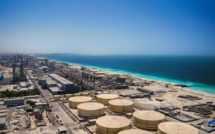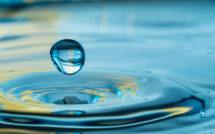

This is part of our special feature on Water in Europe and the World.
Paolo D’Odorico is Professor of Hydrology at the University of California at Berkeley. Originally from Italy, with a PhD in Hydraulic Engineering from the University of Padova, D’Odorico came to the United States in the late 1990s. Paolo D’Odorico is a Guggenheim Fellow, a Fellow of the American Geophysical Union, and a recipient of many awards, including the Sustainability Science Award. D’Odorico is also the Editor of Advances in Water Resources. At the University of Virginia, where he was active before moving to Berkeley, he was one of the key driving forces behind the Global Water Initiative that brings together scholars who study water from across campus. Paolo D’Odorico is a very prolific scholar who covers an unusually wide range of topics. His water research has a strong interdisciplinary bent.
—Peter Debaere for EuropeNow
EuropeNow If we step back and look at the terrain your research has covered, it looks like your research has grown ever more ambitious. You started off and have continued to work in eco-hydrology, but over time, you have branched out and increasingly investigated the intersection between water and our evolving societies. Before we talk about the more water-management related work, can you first say something about some of the key takeaways from your work in eco-hydrology?
Paolo D’Odorico I think it is fair to say that as a young scientist my academic growth was closely associated with ecohydrology, and that the emergence and growth of this field was partly driven by my work and the work of my mentors, colleagues, and students. Ecohydrology is a relatively new and fertile research field. While both ecologists and hydrologists have always been interested in the interactions between water and the biota, the emergence of ecohydrology as a discipline occurred about two decades ago. Around that time, hydrologists became increasingly interested in ecology; at the same time, ecologists started to read the hydrological literature and investigate the role of water in the Earth system. Research in ecohydrology has clarified how water modulates energy flows, biodiversity patterns, and biogeochemical cycles while shaping the habitat for animal, plant, and microbial species (D’Odorico et al., 2010). Some of the early efforts in this field focused on drylands, where water plays a crucial role in limiting ecosystem productivity (D’Odorico and Porporato, 2006).
My own work investigated feedbacks between vegetation dynamics and hydrological processes at the desert margins, both through theoretical models and field work in the southern Kalahari in Southern Africa. We used a systems approach to evaluate the stability and resilience of plant communities along gradients of increasing water stress. Resilience is an incredibly important concept. It is a property of a stable state of a system (for instance the stable existence of vegetation at a certain location) that describes its ability to recover after a perturbation. In other words, resilience tells us to what extent a certain vegetation composition and structure is able to return to its initial state after a disturbance (e.g., drought, overgrazing). Because of feedbacks with hydrological processes many ecosystems have limited resilience and, if disturbed beyond a critical level their configuration may diverge toward an alternative state (e.g., desert conditions). The socio-environmental implications of this transition may be huge if we think about the possible loss of rural livelihoods and the permanent environmental degradation typically resulting from erosion processes and soil loss. In some cases, wind-blown sediments can affect the productivity of remote ecosystems, including the oceans (D’Odorico et al., 2013).
We are currently investigating to what extent the recent and ongoing mobilization of the southern dunes of the Kalahari may trigger dust transport to the Southern Ocean, which is known for its low productivity. Thus, studying ecosystems’ stability and resilience is crucial to understanding and predicting the possible responses of the Earth system to changes in, say, climate and land use. My research group is investigating important interactions among climate, soil, vegetation, and disturbances such as fire, a process we have found to affect soil erosion and precipitation.
EuropeNow In the last ten years, you have increasingly focused on how water use and supply are affected by human interactions. Why this additional focus? And can you say something about your work on virtual water?
Paolo D’Odorico At some point, I realized that in our research we were often trying to identify the ideal system with minimal human impacts. While this approach is important when the focus is on how “nature” works, the effect of human action on hydrological processes and the water cycle is also a fertile and relatively unexplored research field. I started to discover this field years ago when I was teaching an introductory class on “Water on Earth.”
In your question, you refer to the notion of “virtual water.” When I first read the work by Professor Allan, I remained fascinated by the idea that trade dependences are associated with water dependences. Through the (international) trade of food commodities, some societies have access to water resources, more precisely to “virtual water.” Virtual water is not physically present in those commodities: it is just the water used for their production (or “water footprint”). Thus, water is virtually transferred when commodities are exported from production to consumption regions. Equally fascinating was seeing how huge the water footprint of crops and other agricultural commodities is. Indeed, it is much greater than what one would expect (e.g., thousands of liters for a kg of meat). This fact was highlighted by the meticulous work of Professors Hoekstra, Chapagain, and Mekonnen, who formulated the notion of water footprint and calculated the water cost of all the major crops. What I found promising in this field was the possibility of coming up with a more general formulation of the water balance that accounted for virtual water flows.
A “virtual water balance” allows us to express the effect of both local and global actors. Because about 10 percent of the precipitation over land is appropriated by human societies to sustain agricultural production, it is crucial to study the water cycle considering also a social dimension in addition to the strictly environmental/hydrological perspective. Therefore, we started to compare the magnitude of physical and virtual water flows in the water cycle. Our analysis of the virtual water budget allowed us to investigate the nexus among water, food, and population size. We expressed the population’s carrying capacity as a function of local water resources and virtual water flows, and related long-term trajectories of population growth to water availability and patterns of virtual water trade (Suweis et al., 2013). Using trade data, we reconstructed those trade patterns and showed that roughly of 20-24 percent of the water used for food production worldwide is accessed through international trade (Carr et al., 2013).
A question I found to be very intriguing is how the globalization of water through trade is affecting societal resilience. We have addressed this question in different ways: We have looked at how trade can indirectly affect systemic resilience by reducing redundancies and food reserves. We have also developed models to explain how changes in connectivity affect the stability of socio-environmental networks. Thus, while virtual water trade prevents food insecurity, famine, mass migration, and conflict, reliance on trade offers only short-term solutions that “erode” resilience without fully resolving the water scarcity problem. Indeed, only part of the global virtual water trade flows in the direction of reducing inequalities in access to water resources (Carr et al., 2015). As your own work on water as a source of comparative advantage has shown, there are many factors beyond water availability that determine countries’ trade patterns and hence their access to virtual water. Therefore, the study of water resources should explicitly go beyond borders, look at global dimensions, and analyze those “non-water” constraints. I am sure that as an international economist you will agree with me that location-specific research is important, but cross-border analyses are crucial to fully understand human reliance on global water resources. This area of research is only beginning to attract the attention of water scientists.
EuropeNow You and co-authors have written a number of papers on, what is often somewhat provocatively called “water or land grabbing.” What is this about?
Paolo D’Odorico The appropriation and transfer of virtual water can also be associated with the acquisition of agricultural land instead of “just” crops. The last 10-15 years have seen an increase in large-scale land acquisitions, mostly in the developing world. Land investors include agribusiness corporations, retirement funds, as well as foreign governments. In many cases these investments are not driven by the need to gain access to land but to water resources. Therefore, this phenomenon is often referred to as a water “grab,” and typically results as a consequence of “land grabbing” (though the use of this pejorative term is often discouraged because it presumes an a-priory judgment of the outcome of this process).
My colleague Maria Cristina Rulli (Polytechnic of Milan) and I have quantified this phenomenon at the global scale using global datasets of large-scale land investments (Rulli et al., 2013). In collaboration with Jampel Dell’Angelo (VU, Amsterdam) we have identified some criteria to establish when water appropriations through land acquisitions are actual land grabs on the basis of the impacts on local populations. Our work has demonstrated that common property systems are more vulnerable to land and water grabbing (Dell’Angelo et al., 2017).
EuropeNow The tension between population growth and the water it takes to feed this population is indeed a central question. In a number of recent papers, you have taken an interesting perspective on the problem, asking what we can do, in the agricultural sphere, to make sure we do use water most effectively.
Paolo D’Odorico Water availability is for sure a major constraint to food production. The ongoing growth in water demand for food commodities is driven both by the escalation in global population and the increase in per capita consumption as a result of the shift to water-intensive diets. It takes much more water (4-8 times) to produce 1 calorie of animal food (meat, dairy, eggs) than 1 calorie of plant food. We have estimated that by 2050 the ongoing dietary shift will increase by 20 percent the per capita water demand (Davis et al., 2016). Thus, population growth and dietary changes are the major causes of an anticipated water crisis associated with food needs. To meet the increasing food demand humanity could either expand agricultural land or intensify production in currently cultivated areas (or both).
Ecologists have often advocated for the intensification of agricultural production because it does not entail additional deforestation, habitat destruction, land cover change, and associated emissions of greenhouse gases or losses of biodiversity. In many cases, however, agricultural intensification requires the expansion of irrigation into currently rainfed areas, a process that can be limited by water availability. Many rivers on Earth are so strongly depleted by water withdrawals for irrigation that they don’t reach the ocean anymore. Our work has explained to what extent irrigation can be expanded sustainably, without eroding environmental flows or depleting groundwater stocks. We have found that, because of these water constraints, irrigation can be sustainably expanded only in 26 percent of the currently rainfed land, which corresponds to an increase in food production sufficient to feed an additional 2.8 million people (see Rosa et al., 2018).
However, there are also economic, social and institutional constraints because agricultural intensification requires investments in modern agricultural technology (including irrigation) that small-scale farmers in the developing world may be unable to make. Such investments could be enabled by foreign actors, and promote a transition from small-holder farming to large-scale agribusinesses, as discussed in the answer to the previous question. The impacts on rural livelihoods need to be evaluated before advocating for such a change in system of production (see D’Odorico et al., 2018). But are there other options?
So far, we have focused on strategies to increase the demand without wondering whether we can reduce water consumption for food production. There is an increasing interest in new methods to produce more food with less water by planting the right crop in the right place (e.g., Davis et al., 2018), reducing food waste, adopting technology for wastewater reuse, promoting diets that are less water demanding, or using agroecological approaches that reduce evaporation losses (see D’Odorico et al., 2018 for a review). Some of these approaches require investments in irrigation technology.
Other solutions can be based on consumer awareness, research and development, new institutional arrangements, and financial instruments to promote a more efficient use of scarce water resources. For instance, in regions of the world where tradeable water rights exist, we should maybe explore and encourage the establishment of water markets where those rights can be exchanged. This is an interesting research area in which your Global Water Initiative at the University of Virginia has made major breakthroughs, showing how water markets may indeed improve water use efficiency.
EuropeNow Your work has a strong interdisciplinary tendency. It is the case that the scientific community and funding agencies are increasingly encouraging researchers from different fields to tackle one topic together, and to explicitly study the interaction between human and ecosystems. From your own experience what are the challenges that interdisciplinary work faces?
Paolo D’Odorico I have done interdisciplinary research for all my life. When we started our work in ecohydrology, funding agencies did not want to fund it because it was out of the scope of the hydrology and environmental biology programs. Ironically, now the same agencies are funding research in this field when it is not even new anymore. This is just an example of how program managers may miss the opportunity to support new research areas. Some of their programs are so prescriptive that they can just cause damage. Through their prescriptiveness they even try to set the research agenda for academia while it should be the other way around. An example can be found in the narrow way NSF defines coupled natural-human systems. Fortunately, other interdisciplinary programs have started to appear. This is a good sign!
The problem of some interdisciplinary programs is that proposals are reviewed by scholars from different communities that have different standards for scholarly work, metrics of success, and approach to scholarly research. For instance, good research in science aims for new general understanding of patterns and processes without getting lost in site-specific “details.” This requires the use of simplistic/stylized approaches that capture the fundamental aspects of a social-environmental system. While this is true also for some social sciences (such as economics), it doesn’t apply to all of them, because it does not allow for a more nuanced analysis of the effects of culture, tradition, local institutional arrangements, and so on. These more local aspects are indeed very important, and I agree that they should be accounted for. But this means that in some interdisciplinary efforts there are inherent profound differences in the way research is going to be done by the team members. It took us some time to learn how to speak the language of ecohydrology. Now, the challenge is even greater, and will require some open mindedness and ability to understand and appreciate the knowledge-building process in other disciplines. Indeed, I have been fascinated by learning about the different approaches, methods, and research tools used by economists, anthropologists, political scientists, ethicist, political ecologists and so on.
Personally, I am very interested in research that has a global dimension and identifies some global patterns. There are many global data sets available that can be analyzed to investigate some of these global research questions. At the same time, targeted field or regional studies can be used to further validate the understanding gained at the global scale.
EuropeNow How do you see your research evolving? And where would you want water research more broadly move towards?
Paolo D’Odorico I am very intrigued by the study of water inequality, water justice, and human rights to food and water. Most of the research I have seen in this domain tends to focus on local scales and study whether economically disadvantaged communities have worse or better water resources. Similarly, there is a rich body of literature on local studies about gender and race inequality in access to water. I am more interested in a global-scale understanding of the fulfillment of human rights to water and the impact of trade or transnational investments on water inequalities. Our group is presently investigating the hydrologic implications of the transition from small-scale farming to large-scale commercial agriculture in the developing world. We are looking at how this transition is affecting water use in agriculture, its efficiency, and water governance.
It’s hard to say in what direction I would like to see water research move. I realize that every scientist has a different taste and gets excited about different things. I am very interested in the role of water in the metabolisms of societies and ecosystems. But I also recognize the value of research that contributes to fundamental understanding of physical processes at small scales, or in theoretical work that can lead to new research hypotheses, regardless of whether our current access to data, experiments or observations allows us to conclusively test them. I am just not a fan of research that is incremental or “more of the same.” Therefore, if anything, I would like to see more research that is original and thought-provoking, even at the cost of being bold.
Paolo D’Odorico is Professor of Hydrology at the University of California, Berkeley. He received his Ph.D. from the University of Padua (Italy), has been a postdoc at Princeton, and a faculty member at Texas A&M and the University of Virginia. His research focuses on the role of hydrological processes in the functioning of terrestrial ecosystems and societies. His work has analyzed the coupling between hydrological processes and the biota, and contributed to the field of ecohydrology. Through field observations and modeling he is studying new mechanisms of desertification and factors contributing to the resilience of ecosystems at the desert margins. He is currently investigating the global patterns of water use for food and energy production and their impacts on water equity, societal resilience, and food security. He has authored or co-authored 4 books and more than 200 peer-reviewed research articles. He is affiliated with the Global Water Initiative and affiliated with the Center for European Studies.
Peter Debaere is a Professor of Business Administration at the Darden Graduate Business School at the University of Virginia where he teaches MBAs and Executives. Debaere is an international economist with a PhD from the University of Michigan. His research focuses on international trade, multinationals, and trade policy. In recent years, he has also studied the economics of water, focusing on the international and local (i.e. through water markets) allocation of water, as well as the U.S. water quality measurements, and the socio-economic elements of their availability. He leads the Global Water Initiative that bring together scholars from across UVA. Debaere’s papers have been published in top general interest and field journals such as Journal of Political Economy, American Economic Journal: Applied, the Journal of International Economics, and the Journal of Development Economics. He is also on the advisory board of the Center for German Studies and affiliated with the European Studies Program.
References:
Carr, J.A., P. D’Odorico, F. Laio, L. Ridolfi (2013). “Recent history and geography of virtual water trade”, PLoS-ONE, /8(2): e55825. doi:10.1371/ journal.pone.0055825.
Carr, J.A., D.A. Seekell, and P. D’Odorico (2015). “Inequality or injustice in water use for food?” Environm. Research Lett., 10, 024013, doi:10.1088/1748-9326/10/2/024013.
D’Odorico P. and A. Porporato (2006). Dryland Ecohydrology, Springer.
D’Odorico P., A. Bhattachan, K.F. Davis, S. Ravi, C.W. Runyan (2013). “Global desertification: drivers and feedbacks”, Adv. Water Res., 51, 326-344.
D’Odorico P., F. Laio, A. Porporato, L. Ridolfi, A. Rinaldo, and I. Rodriguez-Iturbe (2010) “Ecohydrology of terrestrial ecosystems”. Bioscience, 60(11): 898–907.
D’Odorico, P., K.F. Davis, L. Rosa, J.A. Carr, D. Chiarelli, J. Dell’Angelo, J.A. Gephart, G.K. MacDonald, D.A. Seekell, S Suweis, M.C. Rulli (2017). “The global food-energy-water nexus”, Reviews of Geophysics, 56, 456–531, https://doi.org/10.1029/2017RG000591.
Davis, K.F., J.A. Gephart, K. A. Emery, A.M. Leach, J.N. Galloway, P. D’Odorico, (2016). “Meeting future crop demand with current agricultural resources: Required changes in dietary trends and production efficiencies”, Global Environmental Change, 39, 125-132.
Davis, K.F., M.C. Rulli, A. Seveso, and P. D’Odorico (2017). “Increase in food production and reduction in water use through optimized crop distribution”, Nature Geosciences, doi.org/10.1038/s41561-017-0004-5.
Dell’Angelo, J., M.C. Rulli, P. Marchand, and P. D’Odorico (2017). “The tragedy of the grabbed commons”, World Development, 92, 1-12, 2017. http://dx.doi.org/10.1016/j.worlddev.2016.11.005.
Rosa., L., M.C. Rulli, K.F. Davis, D. Chiarelli, C. Passera, P. D’Odorico (2018). Closing the yield gap while ensuring water sustainability”, Environm. Res. Lett., 13 104002.
Rulli, M.C., A. Saviori, and P. D’Odorico (2013). “Global land and water grabbing”, Proc. Natnl Acad. Sci, USA, PNAS, doi: 10.1073/pnas.1213163110, 2013.
Suweis, S., A. Rinaldo, A. Maritan, and P. D’Odorico (2013). “Water-controlled wealth of nations”, Proc. Natnl Acad. Sci, USA, PNAS, 110(11), 4230-4233, doi: 10.1073/pnas.1222452110.
Published on December 11, 2018.




